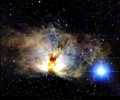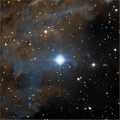© Brad Moore,
Southern Astro
Southern Astro
One example is Zeta Orionis Aa, a type O intermediate luminous supergiant star, the primary star in the Zeta Orionis triple star system. This is seen as the leftmost of the three stars in Orion's Belt, the other being Delta Orionis (Mintaka, a similar type O star) and Epsilon Orionis (Alnilam, again similar but a type B star). It has a diameter about 20 times larger than the sun, is about 28 times heavier, and is about 820 light-years away. Although only about six to ten million years old, it is likely that hydrogen burning has already stopped in the core. It is destined to become a red super giant, similar to Betelgeuse, and its ultimate fate is probably to explode in a supernova within a few million years. To the right is a picture of Zeta Orionis with the Flame Nebula.
Type O Stars
Ref: Aladin Sky Atlas -
STScI Digitized Sky Surveys
STScI Digitized Sky Surveys
Class O stars are very hot and very luminous, some stars being over one million times more luminous than the Sun. Most of their output is in the ultraviolet range giving the stars a blue color. They are some of the rarest and most massive of all stars. Being so massive, and consequently very hot, they burn through their hydrogen very quickly, in some cases within a few million years. Almost all are fated to end their brief lives in spectacular supernova explosions.
Astronomy & Cosmology
-
Stars - Stellar Classes
Another example, about 11 times larger than the sun, about 40 times heavier, and visible to the naked eye, is Zeta Puppis, also known as Naos. A young "runaway star" that is about 970 light-years away from the Sun, it is a spectral class type O5Ia luminous blue-white supergiant. While Zeta Puppis is only about 4 million years old, it has moved more than 400 light-years from where it formed in the Trumpler 10 cluster. Its surface temperature is over 42,000K, and including radiation at all frequencies, it is perhaps as much as 360,000 times more luminous than the sun. If Zeta Puppis were to replace the sun, It is so large and so hot that Earth would need to be about 250 times further away than it is from the sun; 20 to 25 billion miles away, in fact. Although young, it is already dying, and has started to fuse helium into carbon. In about another 2 million years it will have become a huge red supergiant, probably more than 200 million miles across. Soon after, it will explode in a super nova and become a neutron star or, if it retains sufficient mass, a black hole. It spins on its axis about 100 times faster than the sun. NOTE: Some of this data is very recent, and changes much of what was thought about Naos in the past, so may conflict with older data on the web and in print.
HDE 226868 is a type O9.7 Iab intermediate luminous supergiant star. It is between 20 and 40 times the mass of the sun, around 20 times larger, and may be 400,000 times more luminous than the Sun. What is really interesting about this star is that it is a binary with Cygnus X-1, a black hole, as its partner. The radius of Cygnus X-1's orbit around HDE 226868 is only about twice the radius of HDE 226868 itself. The stellar wind coming from HDE 226868 produces an accretion disk around Cygnus X-1 the inner part of which gets heated to millions of degrees producing highly energetic X-rays. The star actually looses about the mass of the sun every 400,000 years. The left image of the system is from the Chandra Space Telescope. To the right there is an artists impression of Cygnus X-1 gravitationally drawing material from the surface of the star HDE 226868 supporting the accretion disk around the black hole.
AE Aurigae, known also as the Flaming Star, is a type O9.5V main sequence star and is about 17 times the mass, and 5 times the size of our Sun. It is another runaway star, about 1,460 light-years from Earth, that was ejected from the Trapezium cluster about two to two and a half million years ago along with Mu Columbae, also a type O9.5V star, and 53 Arietis, a very similar type B1.5V star.






